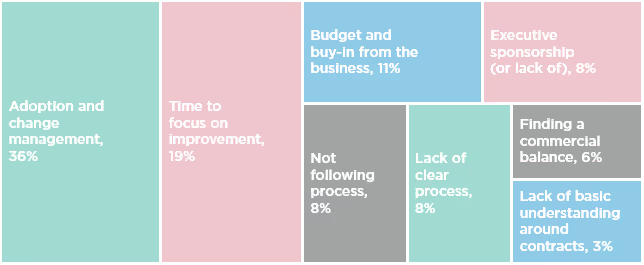Dispatches from the front lines: what’s actually happening in the world of Commercial Contracting

We’re bombarded every day with great stories of innovation, and we asked ourselves a question, how can we really get a perspective on what’s actually happening.
The best way to get that answer: ask our people. With over 2000 lawyers embedded into in house teams, our LODs have a collective perspective that few can match.
That’s how LOD Pulse was born. A real-time view from the boots on the ground, far from any ivory tower. Our Pulse is intended to fill the much–needed gap between what we see on the conference circuit and the realities of the day-to-day.
For our first Pulse, we focused on Commercial Contracting and asked 300 LODs for their views on what they are seeing day in day out. Here is what they shared:
1. The biggest difference comes from the simplest things
We asked our lawyers to tell us what is making a significant and transformational difference to commercial contracting in businesses they have worked in. Spoiler alert: it’s the basics.

And, to the surprise of very few, it’s the shiny new things that have promise but are yet to drive real change.

2. There is a need to focus on legal department basics
When pushed for only one thing that they would focus on to improve commercial contacting, the overwhelming feedback was the Basics (54% of respondents), Technology (27%), Commerciality (11%) and Team Dynamics (8%)
Here are some of the perspectives of our team:
On the basics
- Push for standardisation balanced with a sensible choice.
- Comprehensive playbooks and fallback positions. Historical knowledge set out comprehensively.
- Simplifying the wording and process – it takes time but is worth it.
- Better escalation processes – too many contracts are being auto-generated by people who don’t quite know what they’re doing.
- Don’t forget good communication of clear and well-designed business processes.
On teams
- Work with the business to get earlier engagement with legal.
- Training – simple, focused and delivered in bite-size chunks that the business can digest.
- Taking time to build a solid relationship with sales and procurement. Understand where your clients/customers/colleagues are coming from.
On tech
- Bring more process automation and AI to standard T&Cs review to ensure that lawyers concentrate on business questions and risk management as opposed to semantics.
- Smart self-service tools implemented on-top of great process.
- Document management – don’t overlook how important it is!
Commercial awareness
- Understanding of risk approaches across the markets and proper allocation of risk – you can’t automate that!
- Less legal more “commercialism“.
3. Time and adoption are the biggest barriers to change
When asked about the biggest barriers, our LODs were clear on the main offenders, number one adoption and change management, closely followed by a lack of time to focus on improvements. We’ve presented them in the ”wall of change”. Each block represents the number of times it was referenced by our respondents:

One of our LODs summarised the challenge well, “… resistance to change, add to this a fear and lack of awareness of technology, fear to let go and fear of missing out on a risk, then you’ve got a recipe for change paralysis”. But it goes beyond this, legal departments face a balancing act, the business wants things improved but often won’t sign up to the impacts, “getting the business to understand that efficiencies can only be realised if they accept restrictions of choice is a very hard message”.
The way to get around this is airtight change management, and this is something that busy legal departments struggle to do; “there is a lack of time of those needing to input to do so” and legal teams can’t “find time away from the deals to focus on [the project]”.
And this is the trap that departments find themselves in – good intentions hampered by a lack of slack in the system to really focus on them. And in part, this explains the rise of legal operations – dedicated resources that can focus on, plan and manage change. When asked about the top skills legal operations professionals need, the CLOC board led with high EQ and a strong resilience – because ultimately you’re dealing with people, and people are complicated.
Our key takeaways:
- Focus on the basics, the hard yards that are needed to define and roll out your core operating procedures are crucial. This can’t be overemphasised enough.
- Technology can make a huge difference, but it must be paired with robust operational infrastructure. Our LODs gave an example of a fantastic self-service portal that wasn’t wired into approval routes that anyone recognised.
- Our LODs see a lot of examples of where well-meaning process design, playbooks and other improvements have floundered on the shores of adoption. Processes cannot be designed in a silo. Involve your business and communicate, communicate, communicate. No one will follow new processes if you haven’t got people on board.
- If embarking on a new project gives your teams and stakeholders enough space to really deliver. Dedicated resourcing and support from business teams will be crucial, so plan for it.
Alternatively, give us a call on +44 20 3642 0000 (for Nigel Rea in the UK) and +61 2 8014 5110 (for James Kenney in APAC) or drop us a line at info@lodlaw.com. With one of the world’s largest talent pools of commercial contracting lawyers, deep experience in mapping, improving and building teams around commercial processes and legal engineers that work at the intersection of systems and law, we’re more than happy to share our perspective.


